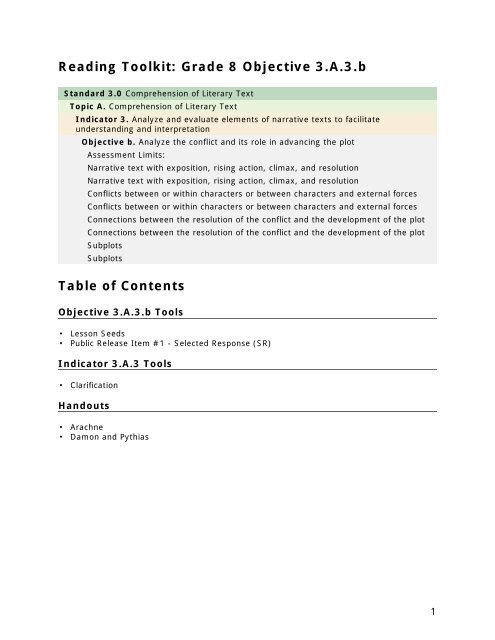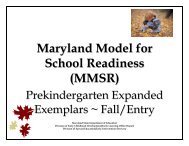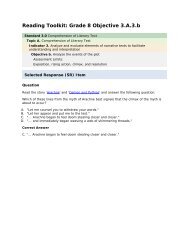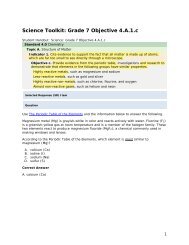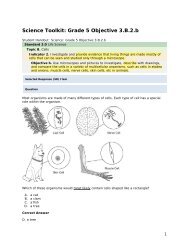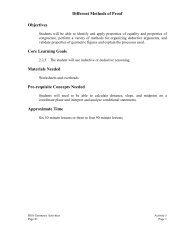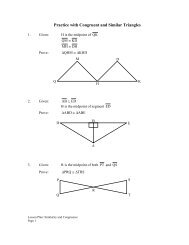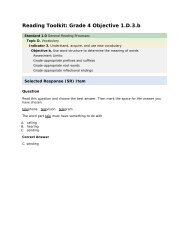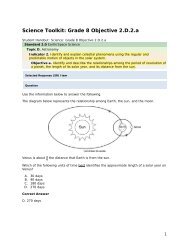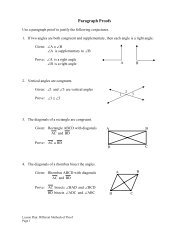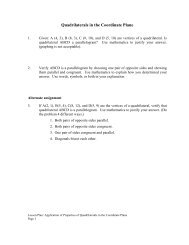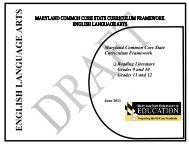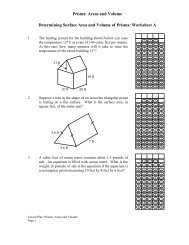Reading grade 8 3.A.3.b - mdk12
Reading grade 8 3.A.3.b - mdk12
Reading grade 8 3.A.3.b - mdk12
Create successful ePaper yourself
Turn your PDF publications into a flip-book with our unique Google optimized e-Paper software.
<strong>Reading</strong> Toolkit: Grade 8 Objective <strong>3.A.3.b</strong><br />
Standard 3.0 Comprehension of Literary Text<br />
Topic A. Comprehension of Literary Text<br />
Indicator 3. Analyze and evaluate elements of narrative texts to facilitate<br />
understanding and interpretation<br />
Objective b. Analyze the conflict and its role in advancing the plot<br />
Assessment Limits:<br />
Narrative text with exposition, rising action, climax, and resolution<br />
Narrative text with exposition, rising action, climax, and resolution<br />
Conflicts between or within characters or between characters and external forces<br />
Conflicts between or within characters or between characters and external forces<br />
Connections between the resolution of the conflict and the development of the plot<br />
Connections between the resolution of the conflict and the development of the plot<br />
Subplots<br />
Subplots<br />
Table of Contents<br />
Objective <strong>3.A.3.b</strong> Tools<br />
• Lesson Seeds<br />
• Public Release Item #1 - Selected Response (SR)<br />
Indicator 3.A.3 Tools<br />
• Clarification<br />
Handouts<br />
• Arachne<br />
• Damon and Pythias<br />
1
<strong>Reading</strong> Toolkit: Grade 8 Objective <strong>3.A.3.b</strong><br />
Lesson Seeds<br />
<strong>Reading</strong> Grade 8 Objective <strong>3.A.3.b</strong><br />
Activities<br />
Students will read a short narrative text. After reading, students will be given a narrative<br />
map that lists all plot elements. Together teacher and students will complete the narrative<br />
map. Next students will be directed to delete or cover from sight the conflict information.<br />
Then teacher and students will discuss how the removal of the conflict changes the plot.<br />
Finally students will list all the changes that removal of the conflict causes within the plot.<br />
Students might then categorize these changes by impact on character, setting, theme, etc...<br />
or create a list from greatest to least impact on the plot.<br />
Narrative Map<br />
Exposition<br />
Rising Action<br />
Conflict<br />
Climax<br />
Falling Action<br />
Resolution<br />
The teacher and students will read a short narrative text and then list each decision made<br />
by a character on a Decision-Making Diagram. This will allow students to see the<br />
relationship between a character's decision and the effect of that decision on the plot.<br />
Students will need to know what the decision is, who made it, and why the decision was<br />
made, listing positive and negative effects for the decision-maker and other characters.<br />
Then each decision should be placed in the time order of the story to determine whether<br />
each decision stands alone or served as a cause for other decisions.<br />
Decision-Making Diagram<br />
Decision # ___<br />
Who?<br />
What?<br />
Why?<br />
Positive Impact<br />
Negative Impact<br />
Students will read a short narrative text. After reading is complete, the teacher and<br />
students will list the story events in the order of their occurrence. Once the list is finished<br />
with teacher direction students will locate the conflict in the text. Next teacher and students<br />
will look at the story events that preceded the conflict and rate each event in regard to that<br />
event's causal relationship to the conflict on a scale of 0-3 with zero indicating no effect and<br />
three indicating major effect.<br />
Content from http://<strong>mdk12</strong>.org/instruction/curriculum/reading/standard3/<strong>grade</strong>8.html 2
<strong>Reading</strong> Toolkit: Grade 8 Objective <strong>3.A.3.b</strong><br />
First, the teacher will locate a narrative text with a major plot and multiple subplots. Prior<br />
to students' reading the text, the teacher will provide them with a completed plot chart for<br />
the major plot. After reviewing that chart, students will be instructed to read the text for<br />
subplots. Once students have read the text and identified the subplots, the subplots should<br />
be charted as was the major plot. Next students and teacher should discuss how the<br />
subplots work in the design of the text determining whether each subplot was a spin-off of<br />
the major plot or exists independently of the major plot.<br />
Content from http://<strong>mdk12</strong>.org/instruction/curriculum/reading/standard3/<strong>grade</strong>8.html 3
<strong>Reading</strong> Toolkit: Grade 8 Objective <strong>3.A.3.b</strong><br />
Clarification<br />
<strong>Reading</strong> Grade 8 Indicator 3.A.3<br />
To show proficiency of the skills stated in this indicator, a reader will demonstrate an<br />
understanding of the elements of narrative texts which are the components through<br />
which a story is told. Identification of each component and its relationship to all other<br />
components in a story assists a reader in comprehension of an entire text. As a text<br />
requires more complex thought processes, a reader advances from the identification,<br />
recognition, and recall of literal elements to the inference, analysis, and evaluation of more<br />
abstract elements. Thinking about all the elements in a story and determining how they fit<br />
together allow the reader to understand and evaluate an entire text and its complexity.<br />
In order to comprehend narrative text, a reader must identify and distinguish among types<br />
of narrative texts. Narrative text tells a story to make a point, to express a personal<br />
opinion, or to provide a reader an enjoyable experience. By recognizing the characteristics<br />
of a variety of literary texts which represent diverse perspectives, a reader is better able to<br />
construct meaning from a text.<br />
Fiction<br />
prose writing that tells an imaginary story<br />
Nonfiction<br />
prose writing that tells about real people, places, and events<br />
Realistic Fiction<br />
prose writing set in the modern world<br />
Science Fiction<br />
prose writing that explores unexpected possibilities of the past or future by using scientific<br />
theories or data and imagination<br />
Historical Fiction<br />
contemporary fiction set in the past, may reference actual people or events<br />
Tall Tales<br />
humorously exaggerated stories about impossible events in which the main characters have<br />
extraordinary abilities<br />
Folktales<br />
stories passed by word of mouth from generation to generation<br />
Folklore<br />
traditions, customs, and stories passed down within a culture<br />
Myth<br />
a traditional story, usually by an unknown author, that answers a basic question about the<br />
world<br />
Legend<br />
a story handed down from the past about a specific person who usually demonstrates heroic<br />
accomplishments<br />
Fables<br />
brief tales that teach lessons about human nature<br />
Fairy Tales<br />
stories about imaginary beings possessing magical powers<br />
Fantasy<br />
literature that contains fantastic or unreal elements<br />
Biography<br />
story of a person's life written by someone else<br />
Autobiography<br />
nonfiction; a person tells about his or her own life<br />
Content from http://<strong>mdk12</strong>.org/instruction/curriculum/reading/standard3/<strong>grade</strong>8.html 4
<strong>Reading</strong> Toolkit: Grade 8 Objective <strong>3.A.3.b</strong><br />
Personal Narrative<br />
personal story; a shorter form of autobiographical writing<br />
Memoir<br />
type of autobiography, usually about a significant experience in the author's life<br />
Journals<br />
a personal record of experiences or reflections<br />
Short Story<br />
a brief work of fiction, usually readable in one session<br />
Essay<br />
a short, cohesive work of nonfiction dealing with a single subject and presenting the writer's<br />
viewpoint<br />
Play<br />
literature intended to be performed by actors in front of an audience; includes script with<br />
dialogue, a cast of characters, and stage directions<br />
Poetry<br />
stories, ideas, and feelings expressed in compact, imaginative, often musical language<br />
Lyric Poetry<br />
poetry that presents the thoughts and feelings of a single speaker<br />
Narrative Poetry<br />
poetry that tells a story and includes narrative elements<br />
To identify, explain and analyze the conflict of a narrative and determine its role in<br />
advancing the plot, a reader must know the structure of a narrative passage.<br />
• In the beginning or exposition of a narrative, information is given about the characters,<br />
their location, and the situation in which they find themselves. This situation creates a<br />
story problem or conflict.<br />
• A conflict can be created by single or multiple sources, either external (caused by<br />
outside forces) or internal (created within the character). Typical types of conflict include<br />
person versus person (problem between and among characters), person versus society<br />
(problem with the laws/beliefs of a group), person versus nature (problem with natural<br />
forces), person versus self (problem within a character regarding decision-making), and<br />
person versus fate (problem which seems out of a character's control). In complex texts,<br />
there may be multiple conflicts.<br />
A character experiencing one of these conflicts may act on or speak about the conflict to<br />
other characters and be motivated to action by the conflict. In some narratives, a conflict<br />
may help clarify character traits for the reader. In other stories, a conflict can also<br />
advance the story events, pushing the characters to a critical point of a story.<br />
A critical reader can identify and determine conflicts, sometimes isolating a common<br />
cause for different conflicts.<br />
• In the rising action, the chronology of events develops and the conflict deepens. At the<br />
climax of the narrative, the deepening conflict reaches a critical point and can alter the<br />
subsequent events.<br />
• As the conflict resolves, the narrative moves toward completion in the falling action.<br />
• Finally, in the resolution the narrative comes to a close. A critical reader should be able<br />
to analyze the resolution of the conflict and trace the plot development to determine how<br />
each stage of that development advanced the plot.<br />
• As the level of a text becomes more difficult and the main plot develops, a subplot of<br />
lesser importance may be present. The subplot may have all the elements that a main<br />
plot does and will tell a story that relates to character development, theme development,<br />
Content from http://<strong>mdk12</strong>.org/instruction/curriculum/reading/standard3/<strong>grade</strong>8.html 5
<strong>Reading</strong> Toolkit: Grade 8 Objective <strong>3.A.3.b</strong><br />
or any other story element. The subplot may have an effect on the outcome of the main<br />
plot or may simply serve as additional, perhaps interesting, element of the story.<br />
To identify, describe, and analyze details that provide information about setting, mood<br />
created by setting, and the role the setting plays in the text, a reader must first know what<br />
information to look for in a text. Setting is where and when a story takes place. Clues to<br />
setting include any of the following: time, day or dates, month, year, season, historical<br />
references, geographical names, landscape details, and weather elements. As the<br />
complexity of a text increases, a reader should take note not only of stated setting details<br />
but also look at more subtle details.<br />
Setting can relay information about characters to a reader. A character's reaction to an<br />
environment, whether familiar or unfamiliar, gives clues to what a character is feeling or<br />
how a character will act in certain circumstances. Changes in setting may signal changes in<br />
mood and development of a character.<br />
Mood is the feeling a text creates within a reader. Setting can help create mood. For<br />
example, a setting in an abandoned house creates an eerie mood. Details of that setting<br />
help establish that uncomfortable mood in a reader. An author also creates mood through<br />
dialogue and word choice.<br />
A critical reader will be attentive to the details of setting, mood, and character and their<br />
integration within a narrative.<br />
Not all narrative texts have theme, but in those that do, there is often more than a single<br />
theme. Theme is the author's message to the reader or the underlying idea of a text. Theme<br />
is often relayed to a reader through characters—what they say, what they do, or what<br />
others say about them-as well as by other narrative elements.<br />
To identify and analyze characterization, a reader must identify a character as a person,<br />
animal, or imaginary being in a narrative. Major characters are most involved in the<br />
conflict of a narrative and are central to much of the story action. Minor characters are<br />
less important and become known to a reader through their interaction with major<br />
characters.<br />
Characters may reveal their attitudes and innermost thoughts through their speech and<br />
their behavior. For more complicated texts, a reader is privileged to know directly the<br />
interior thought processes of a character.This enables a reader to draw conclusions about<br />
why a character might behave the way he/she does and to consider reasons for the type of<br />
interactions that character has with other major or minor characters. Then these<br />
interactions allow other characters to comment about the behavior or speech of that<br />
character. One character's comments about another character form a direct link to<br />
understanding their behavior.<br />
Character speech, action, thought, motivation, and reaction are interdependent and work<br />
together to create well-rounded characters. These elements make a character "real" and<br />
lend believability to the narrative. When characters are made "real," they, like real people,<br />
change and grow. They are called dynamic characters because of their development. Their<br />
opposite, static characters, change not at all or only marginally. The strong, dynamic<br />
character shifts or is shifted by the plot, each exerting an equally forceful influence on each<br />
other. Character and plot then become linked in a narrative.<br />
To identify, explain, and analyze relationships between and among characters, settings, and<br />
events, a reader must discover how each element is linked. Connections between and<br />
among characters are established by elements of characterization. Connections between<br />
Content from http://<strong>mdk12</strong>.org/instruction/curriculum/reading/standard3/<strong>grade</strong>8.html 6
<strong>Reading</strong> Toolkit: Grade 8 Objective <strong>3.A.3.b</strong><br />
and among situations are established by key events and how these events fit together. A<br />
critical reader can determine an organizational pattern, such as cause and effect, between<br />
or among situations and then draw conclusions about characters and their speech and<br />
behaviors within the context of the situation.<br />
For more complicated texts, a critical reader can isolate characters and determine major<br />
from minor characters, the degree to which each is developed, and how they affect each<br />
other and the story events. A critical reader can isolate each story event to see its effect<br />
upon previous events and those that follow it as well as the effect the event exerts upon a<br />
character or characters.<br />
To identify and describe the narrator, a reader must determine the teller of the story. In a<br />
first person narrative, the story is told by a character in the story who uses the nominative<br />
pronouns I, me, and we. In a third person narrative, the narrator is a voice outside the<br />
story action that uses the nominative pronouns he, she, it, and they.<br />
The speaker of a poem is the voice that "talks" to the reader. The speaker of a poem is<br />
not necessarily the poet.<br />
To identify, explain, and analyze the actions of the characters that serve to advance the<br />
plot, a reader should know that characters cause the plot to happen. Usually a story plot is<br />
based on what characters say, do, or believe. Conflicts evolve from interactions between<br />
and among characters. In turn, plots develop around conflicts. What a character does<br />
affects the development of the plot as well as its resolution.<br />
A critical reader of literary text can<br />
• isolate characters, determining if they are major or minor characters, noting their<br />
actions, speech, and thoughts, and observing the attitudes of other characters toward<br />
them<br />
• detail conflicts created by and among characters and determine the type of conflict that<br />
is created<br />
• follow a plot, judging how that plot is driven by character elements or character conflict<br />
• determine how character, conflict, and plot function together<br />
To analyze an author's approach to issues of time in a narrative, a reader must first be able<br />
to follow the elements of a narrative--exposition, rising action, climax, falling action, and<br />
resolution--and to identify key events within each of those divisions of a narrative. Some<br />
events may be related as flashbacks during which the author relates an event out of<br />
sequence at an earlier time. A flashback provides a reader with information that will help<br />
him/her understand setting, characters, or conflict. A critical reader is aware of transitional<br />
words or text features that signal a flashback.<br />
Foreshadowing is present through hints or clues in a text that suggest what may occur<br />
later in the sequence of the narrative's events. Foreshadowing occurs throughout a<br />
narrative and helps to create a tension as the reader anticipates what will happen. A critical<br />
reader understands that plots are not always chronological and that these two techniques<br />
are used to augment a reader's comprehension of and interest in a narrative.<br />
To identify, explain, and analyze point of view and its effect on the meaning of a narrative,<br />
a reader must know that point of view is the perspective from which an author tells a story.<br />
There are two major points of view-first person and third person. In a first person<br />
narrative, the story is told by a character in the story. This narrator is a participant in the<br />
story action and tells the story using the pronouns I, me, and we. This type of narration is<br />
Content from http://<strong>mdk12</strong>.org/instruction/curriculum/reading/standard3/<strong>grade</strong>8.html 7
<strong>Reading</strong> Toolkit: Grade 8 Objective <strong>3.A.3.b</strong><br />
limited because a reader knows only the narrator's perspective of other characters, the<br />
setting, and story events.<br />
In a third person narrative, the story is told by someone who is not a character in the<br />
story. This type of story-teller may relate events much like a reporter relaying the news and<br />
use the nominative pronouns she, he, and they. More often, though, a third person narrator<br />
will relay the thoughts and attitudes of a single character, usually the main character. This<br />
is limited omniscient narration. At times a narrator will relay the thoughts and feelings of<br />
all characters. This is the omniscient or all-knowing narrator.<br />
A critical reader knows that not all narrators are reliable and that they may present<br />
information limited by their own knowledge and observations. This, in turn, may limit a<br />
reader's knowledge. To construct meaning of a narrative, a critical reader must<br />
acknowledge the scope and the limitations of each type of narration and then using other<br />
narrative elements, draw conclusions about meaning.<br />
To analyze the interactions among narrative elements and their contribution to meaning, a<br />
reader must have knowledge of all narrative elements and their dependence upon each<br />
other. A critical reader must determine the type of narrative being read, the type(s) of<br />
conflict in the narrative, the relationship between the setting and the mood of the narrative,<br />
the ways that character is developed, the relationship that exists among the characters, the<br />
setting, the story events, and the point of view from which a narrative is told. Each of these<br />
elements must be analyzed in isolation and then observed as a piece of a whole narrative.<br />
Finally, a critical reader makes judgments about the relative importance of each of these<br />
elements to a particular text, and then using each element and its contribution, constructs<br />
meaning of a whole text.<br />
Content from http://<strong>mdk12</strong>.org/instruction/curriculum/reading/standard3/<strong>grade</strong>8.html 8
<strong>Reading</strong> Toolkit: Grade 8 Objective <strong>3.A.3.b</strong><br />
Public Release #1 - Selected Response (SR) Item<br />
Handout(s):<br />
• Arachne<br />
• Damon and Pythias<br />
<strong>Reading</strong> Grade 8 Objective <strong>3.A.3.b</strong><br />
Read the story 'Arachne' and 'Damon and Pythias' and answer the following question. Which<br />
of these lines from the myth of Arachne best signals that the climax of the myth is about to<br />
occur?<br />
A. "Let me counsel you to withdraw your words."<br />
B. "Let her appear and put me to the test."<br />
C. "... Arachne began to feel doom stealing closer and closer."<br />
D. "... and immediately began weaving a web of shimmering threads."<br />
Correct Answer:<br />
C<br />
Content from http://<strong>mdk12</strong>.org/instruction/curriculum/reading/standard3/<strong>grade</strong>8.html 9
<strong>Reading</strong> Toolkit: Grade 8 Objective <strong>3.A.3.b</strong><br />
Handouts<br />
Many modern words have their roots in Greek Myths. The story of Arachne and her<br />
challenge to the goddess Athena reveals the basis for spiders being called arachnids.<br />
Arachne<br />
by Max J. Herzberg<br />
On another occasion Athena contested 1 for honors with a mortal.<br />
This mortal was Arachne. Her father was Idmon, skilled in the art of<br />
dyeing in purple, and from infancy the girl had been taught her<br />
father's art, joined with that of weaving. In all the land there was<br />
none that surpassed her. So conceited did she become that, lifting<br />
her head proudly to the skies, she challenged Athena herself,<br />
patron of the arts of the household, to compete with her.<br />
Pallas Athena had watched the progress that Arachne was<br />
making, and when she heard the presumptuous challenge, she<br />
assumed the guise of an old woman and came to the spindle at<br />
which Arachne was weaving.<br />
"I am," she said, "a woman old in experience, and I have seen<br />
much in this wide world. To me has come the knowledge of your<br />
challenge to Athena. Let me counsel you to withdraw your words.<br />
You surpass and shall surpass all other mortals, but how vain and<br />
foolish it is to contend with the immortal gods, from whom comes<br />
all skill!"<br />
"Be silent, foolish old woman," replied Arachne scornfully. "I fear<br />
not Athena, but shall put her to shame with my skill. Let her appear<br />
and put me to the test."<br />
Even as she spoke, Athena threw off her disguise and in solemn majesty stood before the<br />
girl.<br />
"Athena is here," she said; and at her words Arachne trembled and realized too late how<br />
insane had been her challenge. But she summoned up her courage and began to weave her<br />
most skillful web. She wove the web in all colors, but mostly in the royal purple of which her<br />
father was the master. At last her work was complete.<br />
Then Athena began to weave, and she depicted wondrous scenes in high Olympus, and<br />
from her very web floated forth divine fragrance of nectar and ambrosia. An unearthly<br />
beauty hovered over the design. In the corner Athena pictured the fate that had come to<br />
mortals who had defied the gods, and as she went from one to the other Arachne began to<br />
feel doom stealing closer and closer. As the last corner was completed, Athena turned to<br />
her, touched her with her magic spindle, and said:<br />
"Punished shall you be for your presumption, but the gods will not let die such skill as<br />
you have shown. Change to an insect, that other mortals may take warning from you, but<br />
ever weave a web of marvelous design."<br />
At the words of Athena, Arachne began to shrink and shrivel. Shortly she was completely<br />
transformed. Where a girl had stood an insect crawled—the spider; and before the eyes of<br />
the terrified beholders it scuttled off to a corner and immediately began weaving a web of<br />
shimmering threads. To this day the Greeks call the spider "arachne."<br />
1 Contested—competed<br />
Content from http://<strong>mdk12</strong>.org/instruction/curriculum/reading/standard3/<strong>grade</strong>8.html 10
<strong>Reading</strong> Toolkit: Grade 8 Objective <strong>3.A.3.b</strong><br />
Damon and Pythias<br />
By Max J. Herzberg<br />
It is likely that these men actually existed.<br />
According to the story, they were subjects of the<br />
tyrant Dionysius, who ruled over Syracuse in Sicily<br />
during the fifth century. Both Damon and Pythias<br />
were renowned for their wisdom and goodness, but<br />
in some manner of which there is no record, Pythias<br />
incurred the anger of the tyrant and was condemned<br />
by him to death. He bore the sentence bravely, but<br />
he asked Dionysius to grant him one<br />
favor—permission to go home and settle his affairs.<br />
Damon offered to be a hostage for the safe return of<br />
his friend.<br />
The tyrant agreed to let Pythias go.<br />
"But you must be here by such and such an<br />
hour," he warned him, "or your friend will die for<br />
you."<br />
Pythias set out for his home, which was a<br />
considerable distance away. He settled his affairs,<br />
divided his goods among his kinsfolk, and set out on<br />
his way back to Syracuse. Unfortunately, however,<br />
he was delayed at every turn. First it was a river swollen with floods that he had to ford,<br />
and then a tremendous storm made the road impassable. He struggled on desperately, and<br />
reached Syracuse in the very nick of time, for the executioner was already lifting up his<br />
sword to behead Damon. Pythias forced his way through the spectators, and cried out:<br />
"Hold your sword! Here I am!" and knelt down to receive the blow. But Dionysius was so<br />
filled with astonishment and admiration at the loyalty of the friends that he pardoned<br />
Pythias, and even asked that he might be admitted to his and Damon's friendship.<br />
Content from http://<strong>mdk12</strong>.org/instruction/curriculum/reading/standard3/<strong>grade</strong>8.html 11


